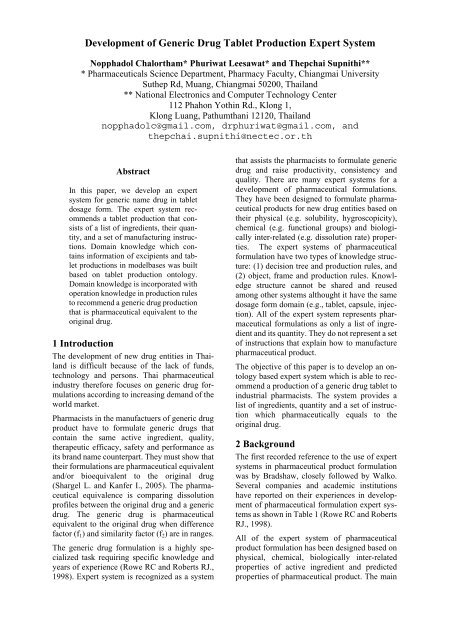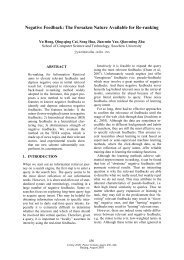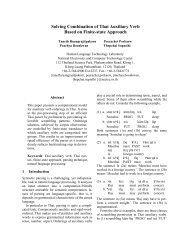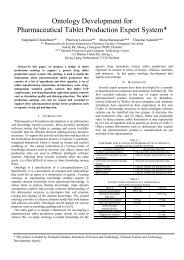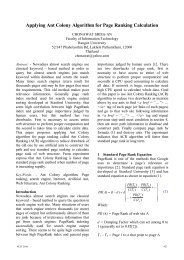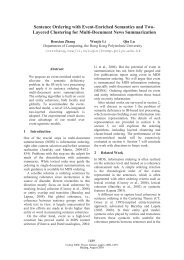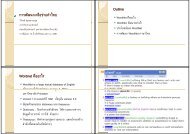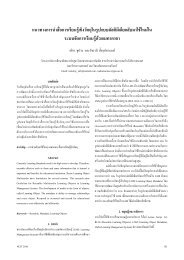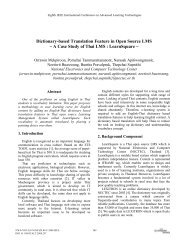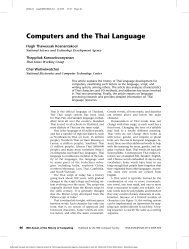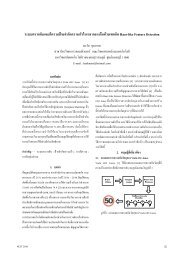Development of Generic Drug Tablet Production Expert ... - LEXiTRON
Development of Generic Drug Tablet Production Expert ... - LEXiTRON
Development of Generic Drug Tablet Production Expert ... - LEXiTRON
You also want an ePaper? Increase the reach of your titles
YUMPU automatically turns print PDFs into web optimized ePapers that Google loves.
<strong>Development</strong> <strong>of</strong> <strong>Generic</strong> <strong>Drug</strong> <strong>Tablet</strong> <strong>Production</strong> <strong>Expert</strong> System<br />
Nopphadol Chalortham* Phuriwat Leesawat* and Thepchai Supnithi**<br />
* Pharmaceuticals Science Department, Pharmacy Faculty, Chiangmai University<br />
Suthep Rd, Muang, Chiangmai 50200, Thailand<br />
** National Electronics and Computer Technology Center<br />
112 Phahon Yothin Rd., Klong 1,<br />
Klong Luang, Pathumthani 12120, Thailand<br />
nopphadolc@gmail.com, drphuriwat@gmail.com, and<br />
thepchai.supnithi@nectec.or.th<br />
Abstract<br />
In this paper, we develop an expert<br />
system for generic name drug in tablet<br />
dosage form. The expert system recommends<br />
a tablet production that consists<br />
<strong>of</strong> a list <strong>of</strong> ingredients, their quantity,<br />
and a set <strong>of</strong> manufacturing instructions.<br />
Domain knowledge which contains<br />
information <strong>of</strong> excipients and tablet<br />
productions in modelbases was built<br />
based on tablet production ontology.<br />
Domain knowledge is incorporated with<br />
operation knowledge in production rules<br />
to recommend a generic drug production<br />
that is pharmaceutical equivalent to the<br />
original drug.<br />
1 Introduction<br />
The development <strong>of</strong> new drug entities in Thailand<br />
is difficult because <strong>of</strong> the lack <strong>of</strong> funds,<br />
technology and persons. Thai pharmaceutical<br />
industry therefore focuses on generic drug formulations<br />
according to increasing demand <strong>of</strong> the<br />
world market.<br />
Pharmacists in the manufactuers <strong>of</strong> generic drug<br />
product have to formulate generic drugs that<br />
contain the same active ingredient, quality,<br />
therapeutic efficacy, safety and performance as<br />
its brand name counterpart. They must show that<br />
their formulations are pharmaceutical equivalent<br />
and/or bioequivalent to the original drug<br />
(Shargel L. and Kanfer I., 2005). The pharmaceutical<br />
equivalence is comparing dissolution<br />
pr<strong>of</strong>iles between the original drug and a generic<br />
drug. The generic drug is pharmaceutical<br />
equivalent to the original drug when difference<br />
factor (f 1 ) and similarity factor (f 2 ) are in ranges.<br />
The generic drug formulation is a highly specialized<br />
task requiring specific knowledge and<br />
years <strong>of</strong> experience (Rowe RC and Roberts RJ.,<br />
1998). <strong>Expert</strong> system is recognized as a system<br />
that assists the pharmacists to formulate generic<br />
drug and raise productivity, consistency and<br />
quality. There are many expert systems for a<br />
development <strong>of</strong> pharmaceutical formulations.<br />
They have been designed to formulate pharmaceutical<br />
products for new drug entities based on<br />
their physical (e.g. solubility, hygroscopicity),<br />
chemical (e.g. functional groups) and biologically<br />
inter-related (e.g. dissolution rate) properties.<br />
The expert systems <strong>of</strong> pharmaceutical<br />
formulation have two types <strong>of</strong> knowledge structure:<br />
(1) decision tree and production rules, and<br />
(2) object, frame and production rules. Knowledge<br />
structure cannot be shared and reused<br />
among other systems althought it have the same<br />
dosage form domain (e.g., tablet, capsule, injection).<br />
All <strong>of</strong> the expert system represents pharmaceutical<br />
formulations as only a list <strong>of</strong> ingredient<br />
and its quantity. They do not represent a set<br />
<strong>of</strong> instructions that explain how to manufacture<br />
pharmaceutical product.<br />
The objective <strong>of</strong> this paper is to develop an ontology<br />
based expert system which is able to recommend<br />
a production <strong>of</strong> a generic drug tablet to<br />
industrial pharmacists. The system provides a<br />
list <strong>of</strong> ingredients, quantity and a set <strong>of</strong> instruction<br />
which pharmaceutically equals to the<br />
original drug.<br />
2 Background<br />
The first recorded reference to the use <strong>of</strong> expert<br />
systems in pharmaceutical product formulation<br />
was by Bradshaw, closely followed by Walko.<br />
Several companies and academic institutions<br />
have reported on their experiences in development<br />
<strong>of</strong> pharmaceutical formulation expert systems<br />
as shown in Table 1 (Rowe RC and Roberts<br />
RJ., 1998).<br />
All <strong>of</strong> the expert system <strong>of</strong> pharmaceutical<br />
product formulation has been designed based on<br />
physical, chemical, biologically inter-related<br />
properties <strong>of</strong> active ingredient and predicted<br />
properties <strong>of</strong> pharmaceutical product. The main
Table 1. Published application <strong>of</strong> pharmaceutical product<br />
formulation expert system<br />
COMPANY/INSTITUTION DOMAIN DEVELOPMENT<br />
TOOL<br />
Cadila Laboratories(India) <strong>Tablet</strong>s PROLOG<br />
University <strong>of</strong> Lodon/Capsugel Capsules C<br />
University <strong>of</strong> Heidelberg<br />
Zeneca Pharmaceuticals<br />
Aerosols<br />
<strong>Tablet</strong>s<br />
Capsules<br />
IV injection<br />
<strong>Tablet</strong>s<br />
Parenterals<br />
Film coatings<br />
San<strong>of</strong>i Research Capsules PFES<br />
Boot Company Topicals PFES<br />
C/SMALLTALK<br />
Product Formulation<br />
<strong>Expert</strong> System(PFES)<br />
output <strong>of</strong> these systems is formulation that consists<br />
<strong>of</strong> a list <strong>of</strong> ingredients and its proportion as<br />
shown in Table 2. However, the different points<br />
<strong>of</strong> these systems are dosage form domain, development<br />
tool and knowledge representation.<br />
The knowledge representation <strong>of</strong> Galenical development<br />
system, San<strong>of</strong>i system, Zeneca system,<br />
and Boots system is in objects, frames and<br />
production rules, on the other hand, the knowledge<br />
representation <strong>of</strong> Cadila laboratories’s<br />
Table 2. Example <strong>of</strong> tablet formulation for a<br />
model drug as generated by the Zeneca System<br />
DRUG A 50.0 MG 150 MG.<br />
Lactose 166.9 mg. -<br />
monohydrate<br />
Dicalcium phosphate<br />
dehydrate<br />
Croscarmellose<br />
sodium<br />
Polyvinyl<br />
pyrrolidone<br />
Hydroxypropyl<br />
methylcellulose<br />
Sodium lauryl<br />
sulphate<br />
- 165.7 mg.<br />
4.8 mg. 7.0 mg.<br />
4.8 mg. -<br />
- 7.0 mg.<br />
0.7 mg. 1.1 mg.<br />
Magnesium stearate 2.4 mg. 3.5 mg.<br />
<strong>Tablet</strong> diameter 8.0 mm 10.0 mm<br />
system and Capsugel system is in decision table<br />
and rules.<br />
3 System Framework<br />
The framework <strong>of</strong> an expert system is shown in<br />
Figure 1. The framework is made up <strong>of</strong> four<br />
modules which are knowledge base, inference<br />
engine, user interface, and developer interface.<br />
The knowledge base module consists <strong>of</strong> domain<br />
knowledge <strong>of</strong> tablet recipes and operational<br />
knowledge <strong>of</strong> rules. The domain knowledge was<br />
constructed based on tablet production ontology.<br />
The information <strong>of</strong> original drug tablet from user<br />
is initially collected. Next, the expert system<br />
retrieves the generic name drug tablet formulation<br />
that is closed to the target formulation from<br />
User<br />
Http Request<br />
Servlets<br />
<strong>Production</strong><br />
rules<br />
System<br />
Tomcat Server<br />
JESS<br />
Engine<br />
Model Base<br />
Ontology<br />
Maintenance<br />
Developer<br />
Figure 1. The <strong>Generic</strong> <strong>Drug</strong> <strong>Tablet</strong> <strong>Production</strong><br />
<strong>Expert</strong> System Framework
Figure 2. The <strong>Tablet</strong> <strong>Production</strong> Ontology<br />
database (domain knowledge). Then, it applies<br />
rules represented in JESS engine (Ernest<br />
Friedman-Hill, 1990) to recommend the most<br />
appropriate tablet formulation that is pharmaceutical<br />
equivalent to the original tablet formulation.<br />
4 Knowledge Acquisition and Knowledge<br />
Representation<br />
Knowledge representation <strong>of</strong> the expert system<br />
can be divided into two groups, domain knowledge<br />
and operation knowledge. Domain<br />
knowledge contains information <strong>of</strong> excipients<br />
following the Handbook <strong>of</strong> Pharmaceutical Excipients<br />
(Raymond C. Rowe et al., 2005) and<br />
modelbases <strong>of</strong> tablet productions. Modelbase <strong>of</strong><br />
tablet production was generated from literature<br />
and patent reviewing information (e.g. drug and<br />
excipient lists, incompatibility and stability <strong>of</strong><br />
drug) based on the tablet production ontology<br />
(Nopphadol Chalortham et al, 2008). The tablet<br />
production ontology is shown in Figure 2. We<br />
use the Hozo environment to develop ontology<br />
in the expert system (Kouji Kozaki et al., 2002).<br />
It is composed <strong>of</strong> ontology editor and model<br />
editor. The tablet production ontology consists<br />
<strong>of</strong> a list <strong>of</strong> ingredients and their quantity, and a<br />
set <strong>of</strong> instructions that explain how to manufacture<br />
tablet in laboratory scale. Modelbase <strong>of</strong><br />
tablet productions in XML pattern is transformed<br />
to Lisp language and loaded in JESS<br />
engine memory. The modelbases <strong>of</strong> tablet<br />
production integrate with operation knowledge<br />
for recommending generic drug tablet productions.<br />
The operation knowledge in production rules<br />
was collected from experience <strong>of</strong> experts and<br />
generic drug tablet formulation experiments.<br />
The operation knowledge is designed to formulate<br />
the generic name drug tablet based on; (1)<br />
active drug’s preformulation study such as<br />
physiochemical properties and (2) the original<br />
drug formulation properties such as disintegration<br />
time, dissolution pr<strong>of</strong>ile.<br />
The components <strong>of</strong> production rules are represented<br />
in the form:<br />
IF THEN .<br />
When the is triggered the <br />
will be executed. An example <strong>of</strong> a simple production<br />
rule in the generic drug tablet production<br />
expert system would be like:
IF (disintegration time <strong>of</strong> the generic drug formulation<br />
is more than disintegration time <strong>of</strong> the<br />
original drug formulation)<br />
And (friability <strong>of</strong> the generic drug formulation is<br />
between 0.5 and 1%)<br />
THEN (increase concentration <strong>of</strong> disintegrant).<br />
Step 1<br />
Step 2<br />
Step 3<br />
Start<br />
Getting the original name<br />
drug formulation<br />
information<br />
Recommending the<br />
generic name drug tablet<br />
production.<br />
Getting the generic name<br />
drug production<br />
No<br />
5 <strong>Generic</strong> <strong>Drug</strong> <strong>Tablet</strong> <strong>Production</strong><br />
<strong>Expert</strong> System<br />
Pharmacists in the generic drug manufacture<br />
input the information <strong>of</strong> trade name drug and/or<br />
a generic name drug production. The system<br />
evaluates the generic name drug production<br />
comparing with the trade name drug formulation.<br />
If the generic name drug production pharmaceutically<br />
equals the trade name drug formulation,<br />
user will examine stability <strong>of</strong> the generic<br />
name drug formulation and/or scale up to larger<br />
batch in the next phase <strong>of</strong> pharmaceutical<br />
product development. Conversely, if the generic<br />
drug production does not pharmaceutically<br />
equal the trade name drug formulation, the system<br />
will recommend a new generic name drug<br />
production.<br />
A flow diagram <strong>of</strong> the system is shown in Figure<br />
3. The first step is the process <strong>of</strong> getting the<br />
information <strong>of</strong> original drug. Next step is the<br />
process <strong>of</strong> getting the generic name drug production.<br />
The following is the evaluation <strong>of</strong><br />
pharmaceutical equivalence between two drugs<br />
formulations. The last step is a process to display<br />
a recommendation <strong>of</strong> the generic name drug<br />
tablet production.<br />
The details <strong>of</strong> the main processes are explained<br />
as follow;<br />
5.1 Getting the Original Name <strong>Drug</strong> information<br />
The expert system gets two parameter groups<br />
from user. The first parameter group is preformulation<br />
study <strong>of</strong> active ingredient (drug) such<br />
as name, physicochemical properties, and<br />
weight in formulation. The second parameter<br />
group is properties <strong>of</strong> original drug product such<br />
as weight <strong>of</strong> tablet, disintegration time and dissolution<br />
pr<strong>of</strong>ile as showed in Figure 4.<br />
5.2 Recommending the <strong>Generic</strong> Name <strong>Drug</strong><br />
<strong>Production</strong><br />
If user inputs only the informaiton <strong>of</strong> the original<br />
name drug formulation, the system will use only<br />
preformulation study <strong>of</strong> active ingredient and the<br />
parameters <strong>of</strong> the original product in recommending<br />
a production <strong>of</strong> generic name drug.<br />
If user input the informaiton <strong>of</strong> the original name<br />
drug formulation and a generic name drug production,<br />
the system will focus on two main<br />
Step 4<br />
Evaluation<br />
Pharmaceutical<br />
Equivalent<br />
Yes<br />
Finish<br />
Figure 3. Flow diagram <strong>of</strong> the expert system <strong>of</strong><br />
generic name drug production<br />
Figure 4. The screen <strong>of</strong> brand name drug<br />
information
points in recommending the generic drug. The<br />
first point, disintegration time is considered with<br />
friability. The disintegration time <strong>of</strong> generic<br />
drug is adjusted between 90-110% <strong>of</strong> disintegration<br />
time <strong>of</strong> the original drug. Modifying<br />
concentration <strong>of</strong> binder and disintegrant is the<br />
first strategy <strong>of</strong> adjusting disintegration time. If<br />
the disintegration time cannot be adjusted in<br />
range, it has to be modified at unit operations or<br />
changed to other excipients.<br />
The second point, difference factor (f 1 ) and<br />
similarity factor (f 2 ) are considered. Strategies<br />
which adjust the f 1 values range between 0 and<br />
15 and f 2 values range between 50 and 100 are<br />
modifing concentrations <strong>of</strong> solubilizer or wetting<br />
agent, adding solubilizer, wetting in the<br />
generic drug formulation, increasing solubility<br />
<strong>of</strong> drug and modifing unit operations.<br />
The output <strong>of</strong> the expert system is shown as<br />
Table 3.<br />
5.3 Getting the <strong>Generic</strong> Name <strong>Drug</strong> <strong>Production</strong><br />
The system gets the generic drug production that<br />
consists <strong>of</strong> a list <strong>of</strong> ingredients and their quantity,<br />
a set <strong>of</strong> tablet manufacturing instructions in<br />
laboratory scale, general standard quality controls<br />
that follow USP requirements (e.g. friability,content<br />
uniformity), and specific formulation<br />
quality controls such as dissolution pr<strong>of</strong>ile and<br />
disintegration time. Figure 5 displays the getting<br />
information <strong>of</strong> generic name drug.<br />
5.4 Evaluation Pharmaceutical Equivalent<br />
This process is to evaluate the pharmaceuticals<br />
equivalent between the original drug and the<br />
generic drug, quality controls <strong>of</strong> the generic drug,<br />
and manufacturing problems. There are three<br />
points to confirm pharmaceutical equivalent <strong>of</strong><br />
generic drug formulation; (1) difference (f 1 ) and<br />
similarity (f 2 ) factors should be in range, (2) the<br />
generic drug formulation passes the standard<br />
quality controls following USP, and (3) manu-<br />
Table 3. An example <strong>of</strong> generic drug production from the expert system<br />
The Recommended <strong>Generic</strong> Name <strong>Drug</strong> <strong>Tablet</strong> <strong>Production</strong><br />
List <strong>of</strong> ingredient<br />
Quality(mg.)<br />
<strong>Drug</strong> A 20<br />
Sodium lauryl sulphate 4.8<br />
Tween80 4.8<br />
Croscarmellose Sodium 7.2<br />
Calcium Carbonate 48<br />
Microcrystalline Cellulose 84<br />
Lactose 68.8<br />
Magnesium Stearate 2.4<br />
<strong>Tablet</strong> weight 240<br />
Instructions<br />
1. Dry mixed between <strong>Drug</strong> A and Sodium lauryl sulphate<br />
2. next, Wet mixed with Tween80<br />
3. next, Dry mixed with Calcium Carbonate<br />
4. next, Dry mixed with Microcrystalline Cellulose<br />
5. next, Dry mixed with Lactose<br />
6. next, Wet mixed with 95% Alcohol<br />
6. next, Size reduce by Sieve number 14<br />
7. next, Drying at 50 °C 5 Hours<br />
8. next, Size reduce by Sieve number 18<br />
9. next, Dry mixed with Croscarmellose Sodium<br />
10. next, Dry mixed with Magnesium Stearate<br />
11. Last, Compress at strength 9 kg.
comparability <strong>of</strong> the curves.<br />
These factors can be determined using the following<br />
formulae:<br />
f<br />
f<br />
1<br />
⎪⎧<br />
= ⎨<br />
⎪⎩<br />
[ ∑ Rt<br />
− Tt<br />
] ⎪⎫<br />
100<br />
[ ] ⎬<br />
∑ Rt<br />
⎪ ⎭<br />
−0.5<br />
⎪⎧<br />
⎡ I<br />
⎪⎫<br />
2 ⎤<br />
= 50log⎨⎢1<br />
+ ∑ wt<br />
( Rt<br />
− T )<br />
⎥ 100⎬<br />
⎪⎩ ⎣ n<br />
⎦ ⎪⎭<br />
2 t<br />
Figure 5. The screen <strong>of</strong> generic name drug information<br />
facturing problems are false.<br />
The difference factor (f 1 ) is a measurement <strong>of</strong><br />
the relative error between the generic drug formulation<br />
curve and the trade name drug formulation<br />
curve, whereas the similarity factor (f 2 ) is<br />
the measurement <strong>of</strong> the similarity <strong>of</strong> the percent<br />
(%) dissolution between the generic drug formulation<br />
curve and the trade name drug formulation<br />
curve. Difference (f 1 ) and similarity (f 2 )<br />
factors should be determined by performing the<br />
requisite dissolution rate testing on 12 units <strong>of</strong><br />
each according to the FDA’s Guidance on Dissolution<br />
Testing <strong>of</strong> Immediate Release Solid<br />
Oral Dosage Form. (Shargel L. and Kanfer I.,<br />
2005) If the f 1 values range between 0 and 15<br />
and f 2 values range between 50 and 100 the<br />
dissolution curves being compared are considered<br />
similar or equivalent. The closer f 1 and f 2<br />
are to 0 and 100, respectively, the better the<br />
Where: f=fit factor; Rt = reference assay at time t<br />
(percent dissolved); Tt = test assay at time t<br />
(percent dissolved); n = number <strong>of</strong> sample points;<br />
wt = weight at time t (optional); Σ = summation<br />
from t = 1 to t = n<br />
5.5 An Example <strong>of</strong> Difference (f 1 ) and Similarity<br />
(f 2 ) Factors Calculation<br />
An example <strong>of</strong> dissolution pr<strong>of</strong>iles <strong>of</strong> a brand<br />
name drug, a generic name drug, and the generic<br />
name drug-add solubilizer illustrated in Figure 4.<br />
Difference factors (f 1 ) and similarity factor (f 2 )<br />
values shown in Table 4 are for the generic name<br />
drug and the generic name drug-add solubilizer<br />
relative to the brand name drug. It indicates that<br />
the generic name drug-add solubilizer is equivalent<br />
to the brand name drug.<br />
6 Conclusion and Future Work<br />
We developed an expert system for generic<br />
name drug in tablet dosage form. The system is<br />
able to recommend a production <strong>of</strong> generic name<br />
drug that consists <strong>of</strong> a list <strong>of</strong> ingredients, quantity<br />
and a set <strong>of</strong> manufacturing instructions. The<br />
generic name drug will be reformulated until it is<br />
%dissolved<br />
120<br />
100<br />
80<br />
60<br />
40<br />
20<br />
0<br />
5 10 15 20 30 45 60<br />
Time (minutes)<br />
Brand name drug <strong>Generic</strong> name drug <strong>Generic</strong> name drug-add<br />
Figure 6. Dissolution pr<strong>of</strong>iles <strong>of</strong> examples <strong>of</strong> difference and similarity factors calculation
Table 3.Difference factors (f 1 ) and similarity factor (f 2 ) values <strong>of</strong> the generic name drug, and the<br />
generic name drug-add solubilizer relative to the brand name drug.<br />
Factor <strong>Generic</strong> name drug <strong>Generic</strong> name drug-add solubilizer<br />
f 1 13.01 8.73<br />
f 2 45.64 53.27<br />
pharmaceutical equivalence to the original drug.<br />
A domain knowledge which was built based on<br />
tablet production ontology consists <strong>of</strong> an excipients<br />
modelbase and a tablet productions<br />
modelbase. The domain knowledge is integrated<br />
with operation knowledge in production rules by<br />
JESS engine. Presently, there are fifteen rules<br />
which represented strategies in recommending<br />
the productin <strong>of</strong> the generic name drug.<br />
In the future, we will add more the productions<br />
<strong>of</strong> generic name drug in the modelbases and<br />
apply the system to generic drug manufacturing<br />
factories.<br />
Acknowledgment<br />
This research is funded by (1) Thailand Graduate<br />
Institution <strong>of</strong> Science and Technology, National<br />
Science and Technology <strong>Development</strong><br />
Agency, Thailand and (2) The Graduate school,<br />
Chiangmai University.<br />
References<br />
Ernest Friedman-Hill, “JESS in Action Rule-Based<br />
System in Java”. Manning Publications. 2003.<br />
Kouji Kozaki, Yoshinobu Kitamura, Mitsuru Ikeda,<br />
and Riichiro Mizoguchi. “Hozo: An Environment<br />
for Building/Using Ontologies Based on Fundamental<br />
Consideration <strong>of</strong> Role and Relation”. Proceeding<br />
<strong>of</strong> the 13 th International Conference<br />
Knowledge Engineering and Knowledge Management(EKAW2002),<br />
pp.213-218, Siguenza,<br />
Spain, 2002.<br />
Nopphadol Chalortham, Phuriwat Leesawat, Marut<br />
Buranarach and Thepchai Supnithi. “Ontology<br />
<strong>Development</strong> for Pharmaceutical <strong>Tablet</strong> <strong>Production</strong><br />
<strong>Expert</strong> System”. Proceeding <strong>of</strong> the Fifth International<br />
Conference in Electrical Engineering/Electronics,<br />
Computer, Telecommunications,<br />
and Information Technoly (ECTICON2008),<br />
Krabi, Thailand. 2008.<br />
Raymond C. Rowe, Paul J. Sheskey and Sian C. owen.<br />
Handbook <strong>of</strong> Pharmaceutical Excipients. APhA<br />
Publications 5 edition, 2005.<br />
Rowe RC. and Roberts RJ. “Artificial Intelligence in<br />
Pharmaceutical product formulation: Knowledge-base<br />
and <strong>Expert</strong> System”. PSTT vol.1, No. 4<br />
July 1998 p.153-159.<br />
Shargel L. and Kanfer I. <strong>Generic</strong> <strong>Drug</strong> Product <strong>Development</strong>:<br />
Solid Dosage Forms. Marcel Dekker.<br />
2005.


